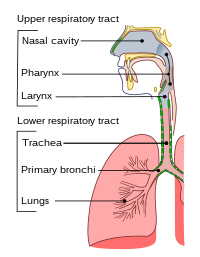
Photo from wikipedia
Abstract Objectives Inflammatory periosteal reaction (IPR) on the visceral surfaces of the ribs has been used in bioarchaeology as an indicator of lower respiratory tract disease. This article presents a… Click to show full abstract
Abstract Objectives Inflammatory periosteal reaction (IPR) on the visceral surfaces of the ribs has been used in bioarchaeology as an indicator of lower respiratory tract disease. This article presents a detailed method for recording IPR on the ribs, even those in severely fragmented states, with the objectives of increasing the consistency of recording and producing true prevalence rates for skeletons so as to improve data comparability between future bioarchaeological studies of lower respiratory tract disease. Materials and methods The presence and prevalence of respiratory‐related IPR were recorded from three different Sudanese cemetery sites using a detailed method for identifying and recording IPR. Sites with variable preservation were chosen to test the applicability of the method. A flowchart to aid in identification of bony changes is presented. The method requires the recording of IPR on three separate sections of the rib (neck, angle, and shaft) and the allocation of ribs into rib cage regions of upper, upper‐middle, middle, lower‐middle, and lower. Results Results demonstrate differences in the distribution of IPR between sites and verify the method's applicability to archeological sites with various levels of skeletal preservation. Discussion While crude prevalence rates can indicate the number of individuals experiencing lower respiratory tract disease within a site, this method can provide information about the distribution of IPR within the rib cage. This should lead to new ways of distinguishing respiratory diseases within archeological populations. This method also allows for comparability between well‐preserved and lesser‐preserved sites by accommodating for rib fragmentation.
Journal Title: American Journal of Physical Anthropology
Year Published: 2019
Link to full text (if available)
Share on Social Media: Sign Up to like & get
recommendations!